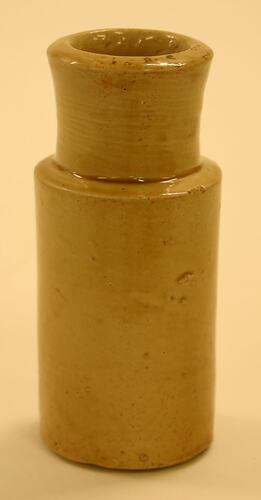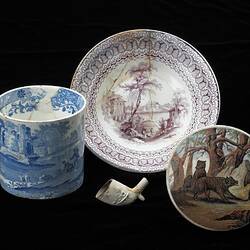Summary
This salt glazed blacking bottle was excavated at the Commonwealth Block site between 1988 and 2003. A blacking bottle was used to store blacking for kitchen stoves or other cleaning liquids.
Food and eating.
Kitchen facilities in the homes of Little Lon were rudimentary. Few people had ovens or ice chests, so perishable foods were bought fresh daily. Most meals were fried or boiled over an open fire. Families with limited facilities would take their Sunday roasts to a nearby bakery for cooking. Even the poorest residents of Little Lon seem to have eaten a considerable amount of meat. Mutton, beef, rabbit and pork came from the Eastern Market in Bourke Street. Oysters and fish were sold from barrows in Flinders Street. Fresh fruit and vegetables were hawked on the streets by Chinese and Italian vendors.
Physical Description
This is a pale ochre coloured salt glazed ceramic blacking bottle. It has cork closure (cork is not present) with no lip and a flanged neck with narrow shoulder. The body is cylindrical with a chamfered heel and a flat base. It is wheel thrown.
Physical Description
Ceramic bung jar. Cork closure, no lip, flanged neck, with narrow shoulder. Body is cylindrical with chamfered heel and a flat base. Jar is wheel thrown. Salt glaze, AS x21 10YR 7/8, Pale ochre. No decoration, Base diameter 61mm, height 145mm. Known as a 'blacking bottle', used to store cleaning liquids.
More Information
-
Collection Names
-
Collecting Areas
-
Acquisition Information
Transfer from Heritage Victoria, Industry Superannuation Property Trust, 03 May 2005
-
Context Number
57/13
-
Site
[TCS] Australia, Victoria, Commonwealth Block, Melbourne
-
Activity
-
Specific Activity
-
Decoration
-
Colour
Brown, Light
-
Form
Flared Rim; Cylindrical Body
-
Shape
Round
-
Classification
-
Category
-
Discipline
-
Type of item
-
Exhibition Collection Management
60 mm (Width), 145 mm (Height)
Width = Diameter
-
Dimensions
60 mm (Width), 149 mm (Height)
Measurement From Conservation. ERROR:height:1=50 mouth
-
EAMC Measurements
145 (Height), 61 (Outside Diameter)
-
Keywords


